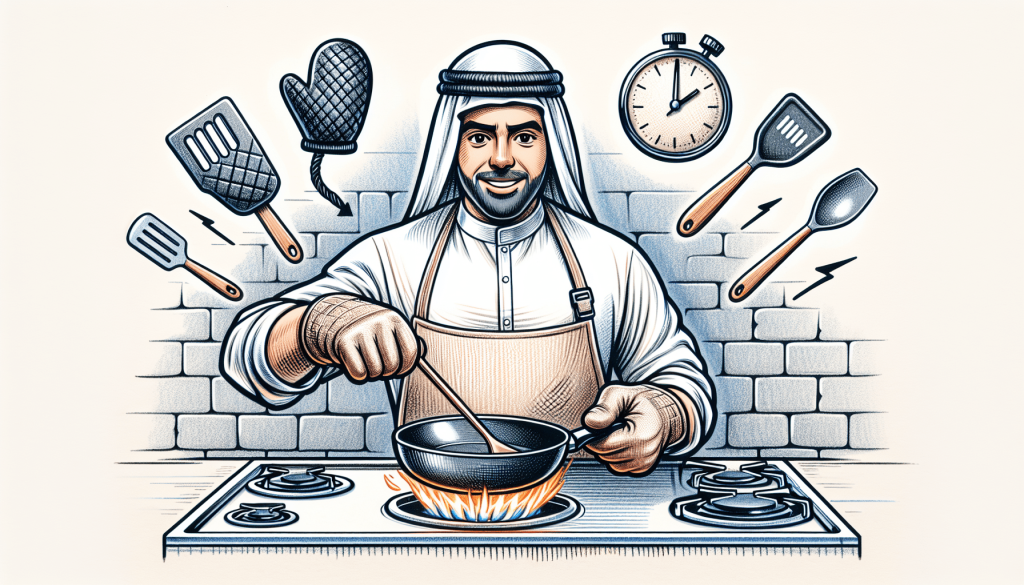Are you a fan of cooking with nonstick cookware but worried about the potential health risks? In this article, you’ll discover practical tips and guidelines on how to safely cook with your nonstick pots and pans. From choosing the right cookware to proper cleaning and maintenance, we’ll help you enjoy the convenience and ease of nonstick cooking without compromising your health. So, let’s dive in and learn how to protect yourself and your loved ones while creating delicious meals in the kitchen!
Choosing the Right Nonstick Cookware
When it comes to choosing nonstick cookware, there are a few key factors to consider. Firstly, look for cookware with a PFOA-free label. PFOA, or perfluorooctanoic acid, is a chemical that was previously used to make nonstick coatings but has since been phased out due to health concerns. Opting for cookware that is labeled PFOA-free ensures that you are selecting a safer option for your kitchen.
Another important factor to consider is the thickness and durability of the nonstick coating. Look for cookware with a thick, durable nonstick coating that will withstand regular use. A sturdy coating will be less likely to chip or peel, ensuring that your nonstick cookware will last longer and remain effective.
Additionally, consider the type of nonstick coating used. There are different types of nonstick coatings available, such as ceramic, Teflon, and diamond-infused coatings. Each type has its own unique properties and advantages, so it’s important to choose one that best suits your cooking style and preferences.
Prepping Nonstick Cookware for Use
Before you start using your nonstick cookware, it’s important to properly prep it to ensure optimal performance and longevity. Start by washing the cookware thoroughly with mild dish soap and warm water. This will remove any residue or dirt that may be present, ensuring a clean cooking surface.
Next, consider seasoning the cookware before its first use. Seasoning helps to enhance the nonstick properties of the coating and creates a protective layer. To season your nonstick cookware, simply apply a thin layer of cooking oil onto the surface and heat it gently for a few minutes. Once cooled, wipe off any excess oil and your cookware is ready to use.
Lastly, it’s important to avoid using metal utensils that can damage the nonstick surface. Opt for utensils made of silicone, nylon, or wood to prevent scratching or scraping the coating. This will help to maintain the nonstick properties of your cookware and ensure its longevity.

Using Nonstick Cookware on the Stove
When using nonstick cookware on the stove, there are a few important tips to keep in mind. Firstly, use low to medium heat settings. Nonstick coatings are designed to heat up quickly and evenly, so there’s no need for high heat. Using high heat can actually cause damage to the coating, so it’s best to avoid it whenever possible.
Additionally, preheat the cookware before adding any ingredients. This helps to create a barrier between the food and the cookware, preventing sticking and ensuring even cooking. Simply heat the empty pan for a minute or two before adding your ingredients.
Lastly, it’s important to avoid using cooking sprays on nonstick pans. Cooking sprays can leave behind a residue that can build up over time and diminish the nonstick properties of the coating. Instead, use a small amount of oil or butter to lightly coat the surface of the pan.
Cooking with Nonstick Cookware
When cooking with nonstick cookware, there are a few tips to keep in mind for optimal results. Firstly, use a small amount of oil or butter for better flavor. While nonstick cookware requires less oil than traditional pans, adding a small amount will help to enhance the flavor of your dishes.
It’s also important to avoid using high heat when cooking with nonstick cookware. High heat can cause the coating to break down and become less effective over time. Stick to low to medium heat settings for best results.
Additionally, it’s best to avoid cooking acidic or sticky foods for prolonged periods of time in nonstick cookware. Acidic ingredients like lemon juice or tomatoes can react with the nonstick coating, while sticky foods like caramel can cause the coating to become damaged. If you do need to cook these types of foods, consider using alternative cookware or adding a protective layer of parchment paper.

Cleaning Nonstick Cookware
Proper cleaning is essential for maintaining the performance and longevity of your nonstick cookware. After each use, allow the cookware to cool before cleaning. Placing hot or warm nonstick cookware in cold water can cause warping or damage to the coating.
To clean nonstick cookware, hand wash it with a soft sponge or cloth using mild dish soap and warm water. Avoid using abrasive cleaners or scrub brushes, as these can scratch or damage the nonstick coating. If there is stuck-on food, soak the pan in warm soapy water to loosen it before gently scrubbing.
Storing Nonstick Cookware
To ensure the longevity of your nonstick cookware, it’s important to store it properly. When stacking nonstick cookware, use protectors in between each piece to prevent scratching or damage to the coating. These protectors can be found in cookware sets or purchased separately.
If possible, consider hanging nonstick pots and pans. This not only saves storage space but also prevents any potential stacking mishaps that could damage the nonstick coating.
Lastly, store your nonstick cookware in a dry and cool place to prevent moisture buildup. Moisture can cause the nonstick coating to deteriorate over time, so it’s best to avoid humid storage areas.
Recognizing Signs of Wear and Tear
Over time, nonstick cookware may start to show signs of wear and tear. It’s important to recognize these signs early to ensure both the safety and effectiveness of your cookware. Inspect the nonstick surface regularly for scratches or flaking. If you notice any damage to the coating, it’s time to replace the cookware.
Similarly, look for signs of warping or loose handles. Warping can affect the cooking performance of the cookware and loose handles can pose a safety risk. If you notice either of these issues, it’s best to replace the cookware to ensure safe and effective cooking.
Avoiding Health Risks of Nonstick Cookware
While nonstick cookware is generally considered safe, there are a few precautions you can take to minimize any potential health risks. Firstly, cook in well-ventilated areas to minimize fumes. Overheating nonstick cookware can release toxic fumes, so it’s important to ensure proper ventilation in your kitchen.
Avoid overheating nonstick cookware altogether to prevent the release of toxic fumes. Follow the recommended heat settings for your specific cookware and always use low to medium heat.
If you have concerns about the health risks associated with nonstick cookware, consider using alternative cookware options. Stainless steel, cast iron, and ceramic cookware are all great alternatives that do not have nonstick coatings.
Dealing with Accidental Overheating
In the event of accidental overheating, it’s important to act quickly and appropriately. Firstly, remove the cookware from heat immediately to prevent further damage or potential injury. Allow the cookware to cool completely before handling or cleaning.
To help dissipate any fumes that may have been released, ventilate the kitchen by opening windows or using fans. This will help to remove any potentially harmful fumes from the air.
Longevity of Nonstick Cookware
By following a few simple guidelines, you can extend the longevity of your nonstick cookware and ensure it performs optimally for years to come. Firstly, avoid using metal utensils that can scratch or damage the nonstick surface. Opt for utensils made of silicone, nylon, or wood to prevent any potential damage.
Proper storage is also key to preventing damage to your nonstick cookware. Always stack nonstick cookware with protectors in between to prevent scratching or chipping of the coating. It’s also important to follow the manufacturer’s instructions for care and maintenance to ensure the longevity and performance of your cookware.
In conclusion, cooking with nonstick cookware can be safe and enjoyable as long as you choose the right cookware, properly prep and use it, and take the necessary precautions. By following these guidelines, you can ensure that your nonstick cookware remains in great condition, providing you with many delicious meals for years to come.
